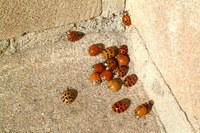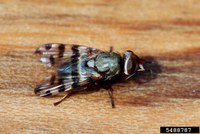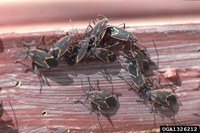Watch for fall-invading insects in the home
(Click an image below to view a high-resolution image that can be downloaded)
-

These insects are harmless to humans, but can be a nuisance to homeowners. (Photo by James Kalisch, University of Nebraska-Lincoln) -

Adult picture-winged fly. (Photo by Whitney Cranshaw, Colorado State University, Bugwood.org) -

Boxelder bug. (Photo by Whitney Cranshaw, Colorado State University, Bugwood.org)
Some insects invade our homes as the fall weather turns cold outside, including the picture-winged fly or attic fly, boxelder bugs and multicolored Asian lady beetles, says Janet Knodel, North Dakota State University Extension entomologist.
“These insects like to overwinter in people’s homes, especially in older homes,” says Knodel. “Fortunately, these do not sting, destroy furniture or clothing, or carry any diseases. Once in the house, they warm up and will, fly or crawl about the house. Homeowners often find these lethargic insects on windows where they are attracted to sunlight. These insects are harmless, but can be a nuisance to homeowners.”
During the cool autumn months, picture-winged flies, boxelder bugs and multicolored Asian lady beetles can enter attics, dormers, usually the highest rooms of the home, by forcing themselves through various cracks, crevices and openings. The southern and western exposures of houses are often the warmest where most of the insects will concentrate. They hibernate and overwinter within the walls, in attics, window casings, dark corners in closets and curtains. Boxelder bugs and multicolored Asian lady beetles can stain carpet and furniture if squished.
The picture-winged fly is similar in appearance to the house fly but has banded or striped wings. The adult boxelder bug is about one-half inch long, brightly colored with three red lines down the prothorax. The multicolored Asian lady beetle is about one-third inch long and ranges from orange to red with up to 19 black spots on the wing covers. This lady beetle has a black “M” marking behind its head.
“Many of the insects fail to survive the winter, so dead insects can accumulate in attics and wall voids,” says Knodel. “Contrary to popular belief, these insects do not breed or multiply in homes. They do not feed during the winter. They do not bite, except for the multicolored Asian ladybeetle. Even after these insects are cleaned up from a room, it can be littered by additional dead insects again within days. The continuous presence of insects can be very frustrating.”
“The control of these insects cannot be effective until the openings through which they enter are closed,” advises Knodel. While total elimination of insects is virtually impossible, maintaining the house in good physical shape will greatly reduce any infestation. Use tight fitting window screens, especially on the upstairs and attic windows and vents. Screen attic ventilators, attic louvers and utility entry areas. Caulk and seal all cracks and openings near windows, doors, vents and other possible entry sites.
Extension entomologists do not recommend any insecticides inside the home. Insects can be removed with a vacuum, broom and dust pan or window fly traps. It is most important to find and seal or screen the entry points where the insects are getting into the home.
NDSU Agriculture Communication – Oct. 27, 2023
Source: Janet Knodel, 701-231-7915, janet.knodel@ndsu.edu
Editor: Kelli Anderson, 701-231-7881, kelli.c.anderson@ndsu.edu

